Thirty years, five operas and one upcoming production. That’s how long we’ve been working with the renowned director Francesca Zambello. In anticipation of our audio stream of Billy Budd, we caught up with the internationally recognized director to reminisce on the production and her time at LA Opera. (FYI: there are some major Billy Budd plot spoilers ahead.)
The story starts in 1991, back when Peter Hemmings was general director. We wanted an up-and-coming creative to direct our production of The Trojans, one of the largest scaled of all operas, with a gigantic cast and a monumental story drawn from mythology. Enter Francesca Zambello, a young director who had been making a big mark in smaller opera houses and theaters around the U.S. and Europe.
“I was very fortunate to make my debut in Los Angeles when Peter Hemmings was the general director. He invited me to direct a production of The Trojans, which is Berlioz's epic work. It was a phenomenal experience with an incredible cast and great conductor. I was just really beginning my career and moving into bigger houses at that time.”
For just starting out in her career, Zambello’s company debut was one for the books. It was so good, in fact, that we’ve worked with her regularly from then on.
“My relationship with LA Opera has actually continued now for almost 30 years. I’m lucky to have directed a number of things there every few years—The Trojans, Florencia en el Amazonas, Billy Budd, Porgy and Bess and Candide. And then of course, there’s the upcoming production of Aida.”
But even after three decades of collaboration, there still hasn’t been a production quite like Billy Budd.
“Benjamin Britten's masterpiece Billy Budd is truly one of the most rewarding operas, I think, in the canon. It is a powerful tale, built really on Melville's short story but so expanded by Britten in a way that you really can peer into the characters. Of course, it’s a very simple story, but it requires enormous resources to do the work. There's a large chorus, a children's chorus, extras and a cast of, I think, about 20 named principal roles, because it takes place on an English warship in the time of war against France.”
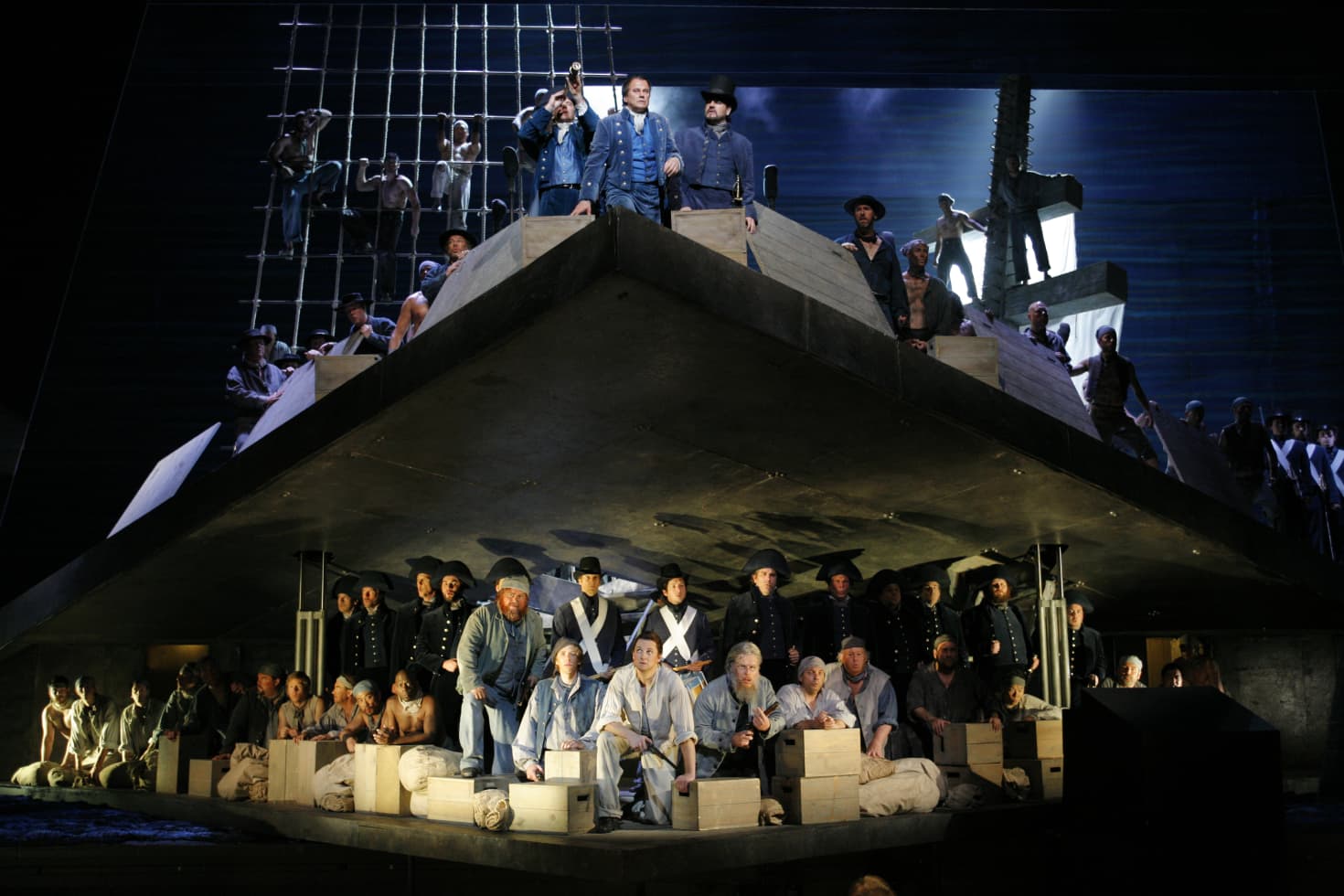
The above and below decks of the set (Photo: Robert Millard)
Creating that warship was no easy task either. It took a whole team and a ton of research to create, cultivate and curate the look, feel and mechanics of the set and costumes.
“I first started out by getting an English designer, Alison Chitty, a longtime collaborator on many different projects. And we really studied this part of history. It’s so well documented; from the English perspective, the French perspective, the world of the warships. There are many to visit, which we did visit.”
And those visits inspired the extraordinary set that ended up on stage (even if they didn’t build an actual boat inside the Dorothy Chandler Pavilion).
“We had to create an illusion of a boat: below deck, above deck. All of these locations have to make you feel like you’re in that world. So we created something that was rather abstract. The boat is actually a very large rectangle on a diagonal, and there's a huge mast at the upstage left part of the boat, which also, in a way represents a cross, because often Billy Budd is connected with a sort of Christlike sense about him.”
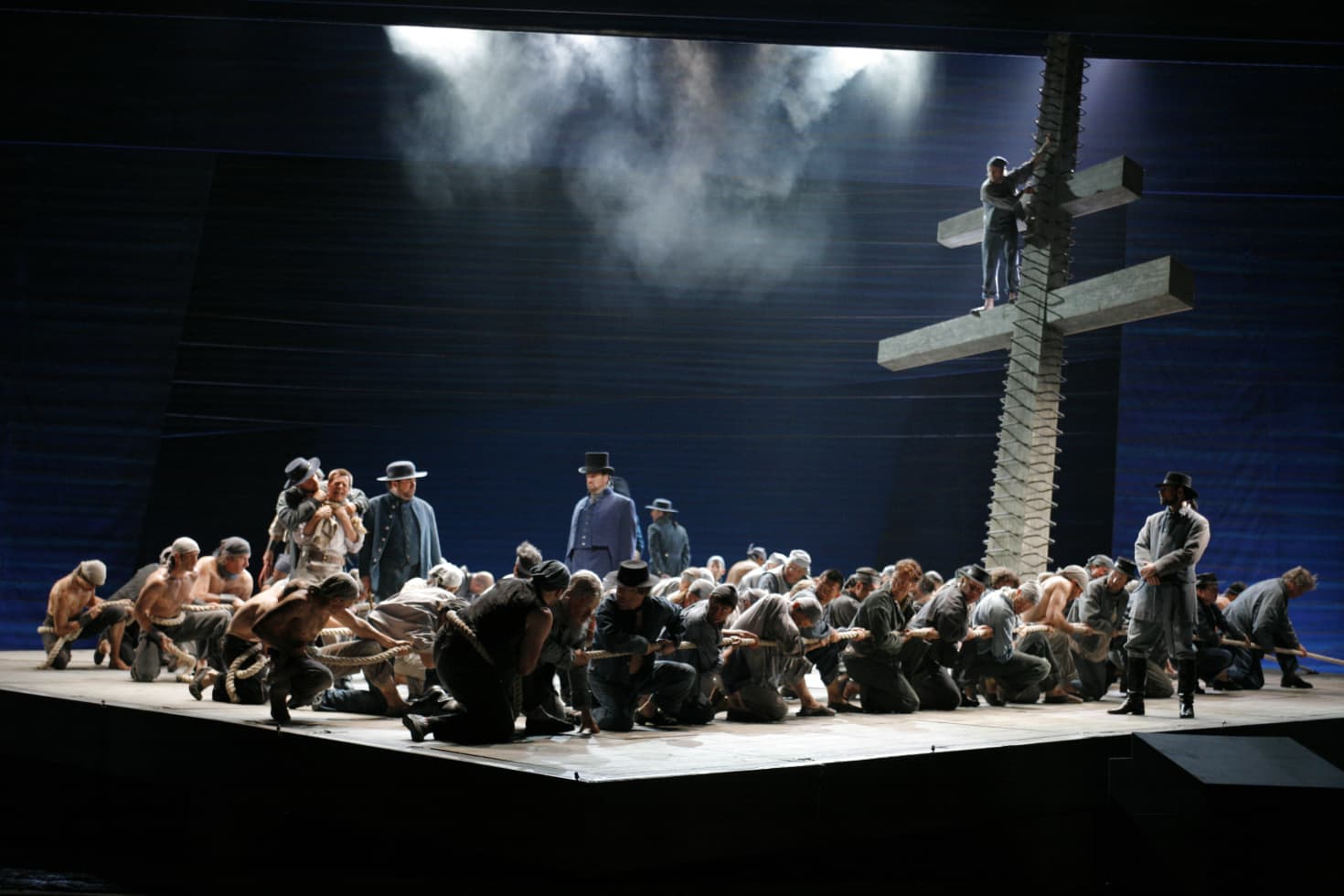
The "cross" of the ship (Photo: Robert Millard)
“The magic of this set was that in the middle of the boat, it would hinge and the whole top deck would open up to reveal the insides, the below-deck world of all the sailors, all their hammocks, the ropes, everything down below. We tried to suggest that there was the below deck, the captain's quarters and then above deck.”
“Then around the outside of this huge wooden planked structure was neon, which suggested the sea. The thing that I think is so genius about the opera is that everything happens on the boat, like it’s an island. People can't get off it unless they’re thrown overboard. Stories that happen on islands and in very isolated places are always great to direct because they give you a world that no one can go in and out from.”
And just like on any magnificent boat, the captain and crew aren’t complete without their (color-coded) uniforms.
“What we chose to do was, rather than making historical representations, we used the gradation of color to suggest rank so that the captains of the ship had the bluest uniform. They didn't have a lot of baubles and bangles, but they were a very striking, strong blue. Then all the other officers go down through darker shades of blue until we got to the master of arms, Claggart, the villain in the piece. And he was kind of in a murky green blue, a very, to me, kind of a scary color.”
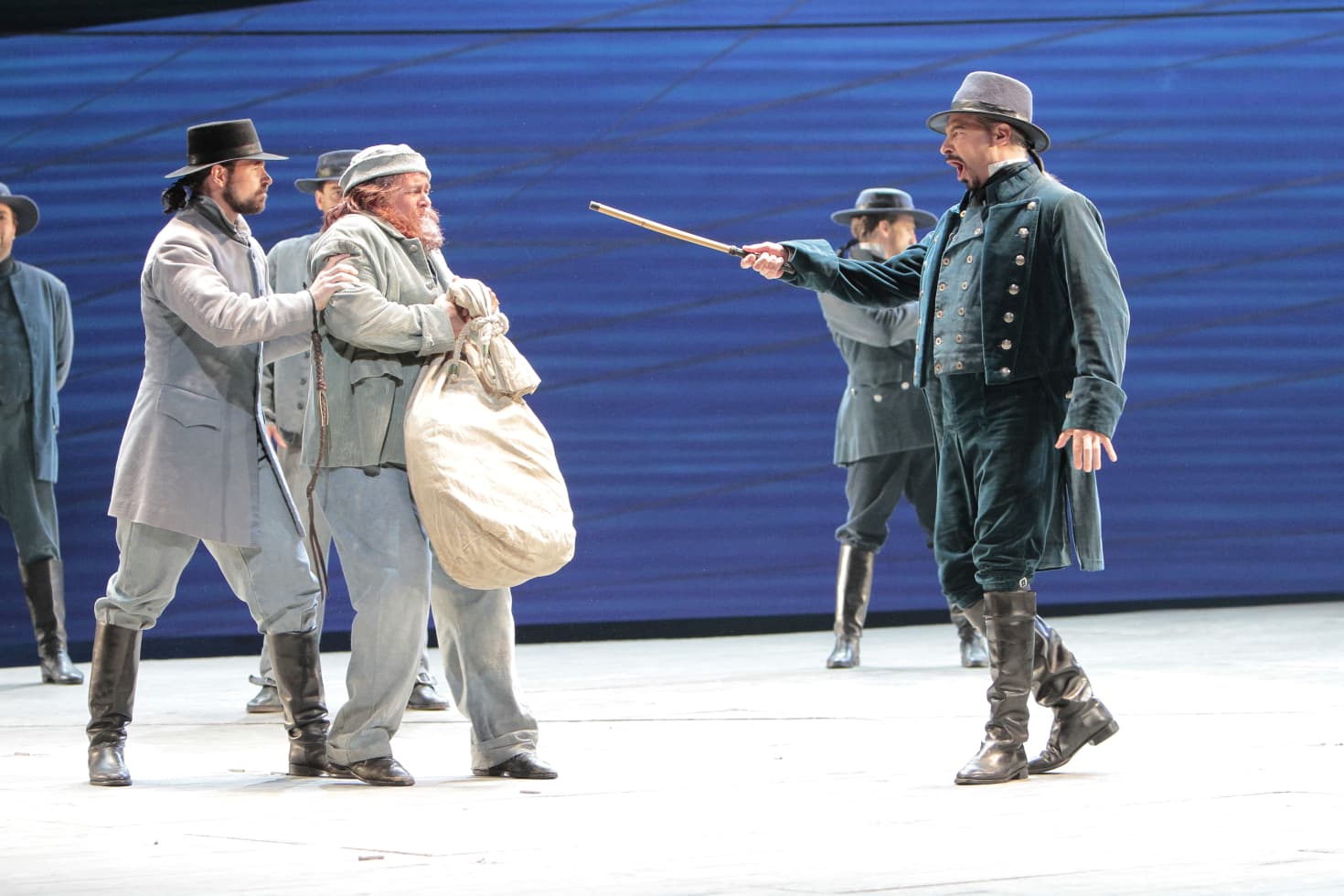
The different colored uniforms (Photo: Robert Millard)
“We made Billy as close to white as possible. He had a white shirt with a bandana, a kerchief, and sort of off-white ivory pants. And then all the other sailors were in shades of white and pale blue all the way down to the darkest colors. And so it was really a color world that suggested the rank rather than trying to give people the authentic this and that. And I think the visual impact of that was very powerful. You would see these blue officers in a sea of pale blue and whites of the sailors.”
Once the captain and crew are on board the boat and fitted in their uniforms, it’s time for the action to begin. As you might expect, that action is just as carefully crafted as the rest of the production-- and maybe a bit more complex to coordinate.
“The production as a whole is complex because, particularly, the first half of the opera has many scenes told by the chorus, and so every chorister, of course, is an individual, a unique character on that boat. Many of them were, as they say, pressed into service, not just drafted but dragged off the street. And so really, the first half of the story, all the way up through the magnificent battle scene, is so many scenes with the chorus that weave the tale together until the crime happens, where Billy Budd kills John Claggart.”
“And from there, basically until the end of the piece, it is much smaller, more intimate scenes, including the remarkable trial at sea, which condemns Budd to death for what was basically an accidental killing of Claggart, which brings us, perhaps, to the most difficult aspect of the piece—the hanging of Billy Budd.”
Coordinating the climax of any opera is always a bit difficult, but this one posed even more of a significant challenge (for... obvious reasons).
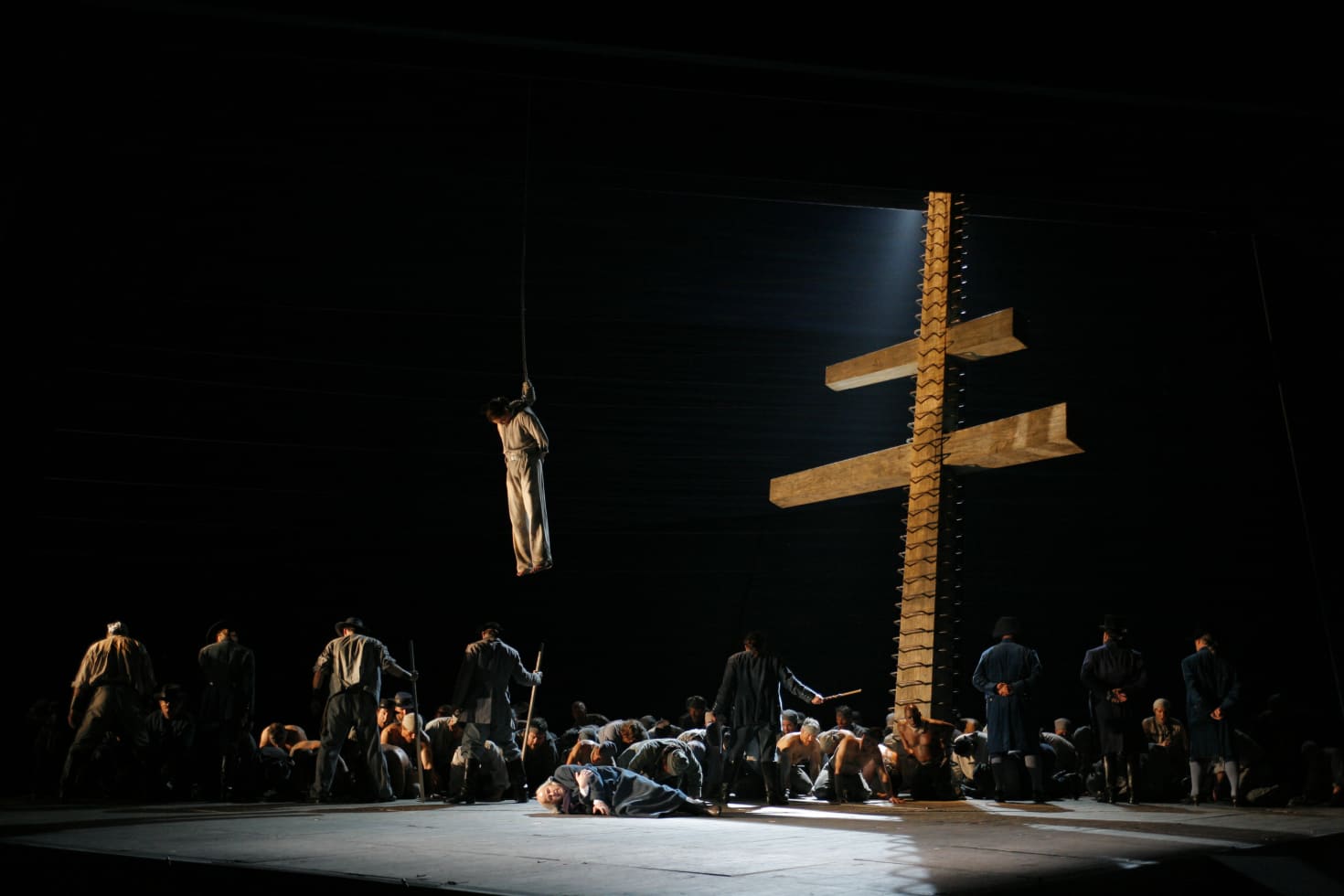
The hanging of Billy Budd (Photo: Robert Millard)
“Of course, hanging an actor live on stage requires an enormous amount of duress on the harness under their costume. When the noose appeared from the flies above, the noose went around his neck. But there was a hook that clipped on to the harness, so that he was lifted up by his fellow sailors, which was a kind of punishment that the officers made him do before he was dropped from a board.”
“And as he was dropped, the rope sort of goes from being slack to straight to hanging down, and it's as if his neck is broken. And then we chose to raise him up very, very slowly, as if he was ascending to heaven, to suggest a kind of metaphor that the soul was released.”
“That whole scene is technically very complex and of course requires an enormous amount of safety checks and little tricks on our end. Even though his hands appear tied behind his back, they're not really tied so that if he is nervous about something, he can reach out and grab it.”
But through all of the trails, challenges and technicalities of the piece, Zambello still considers it one of the most memorable productions she’s worked on.
“This is one of those productions that I have so many wonderful memories from, probably because it's been around a while. I think its success is really in the creative visuals of it. The abstractness of the set, I think, allowed audiences into the story.”
Dive into the story (but not overboard) with us starting Tuesday, April 27, at 5:00 p.m. (PT) when the audio stream premieres live.



